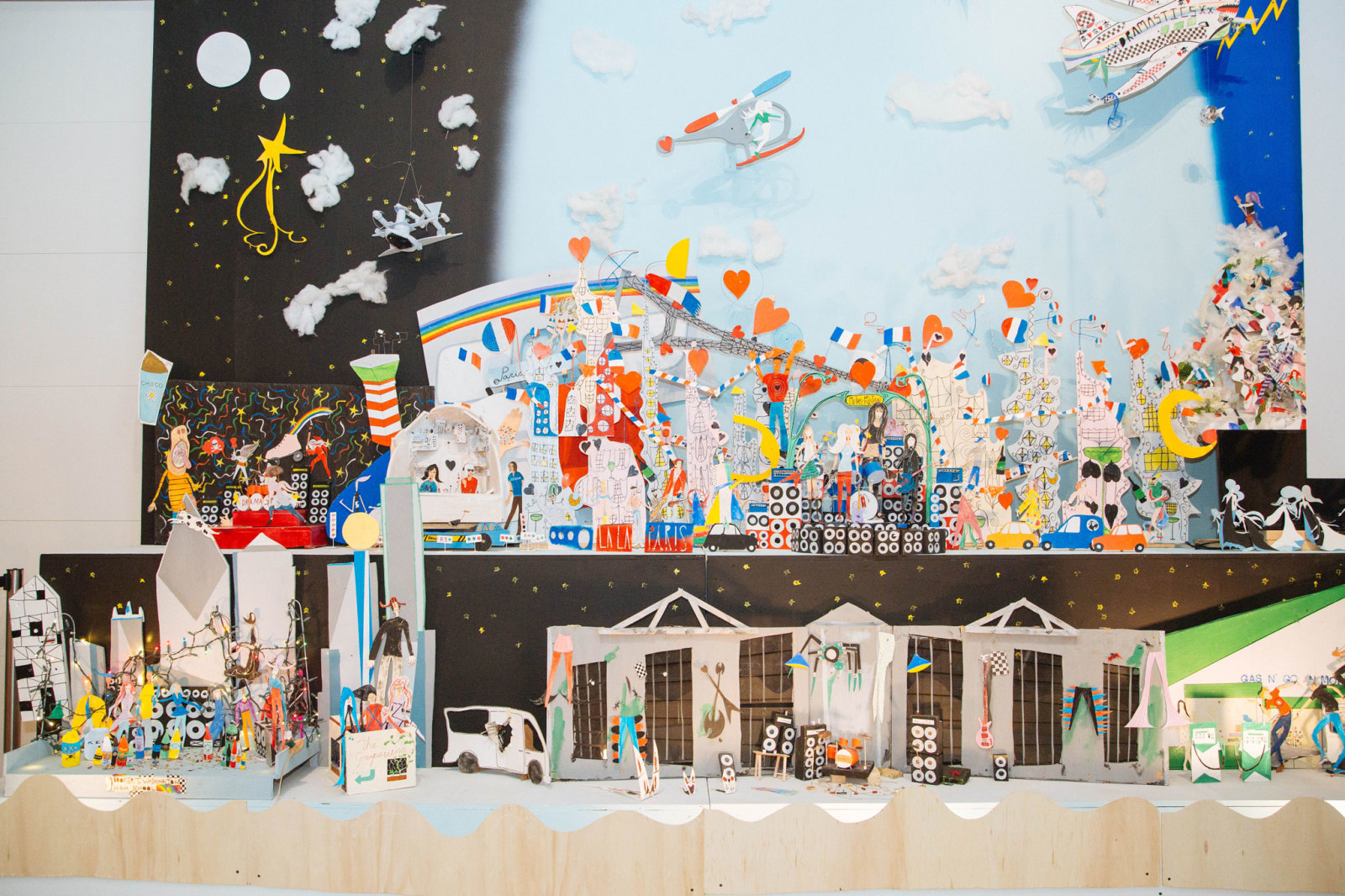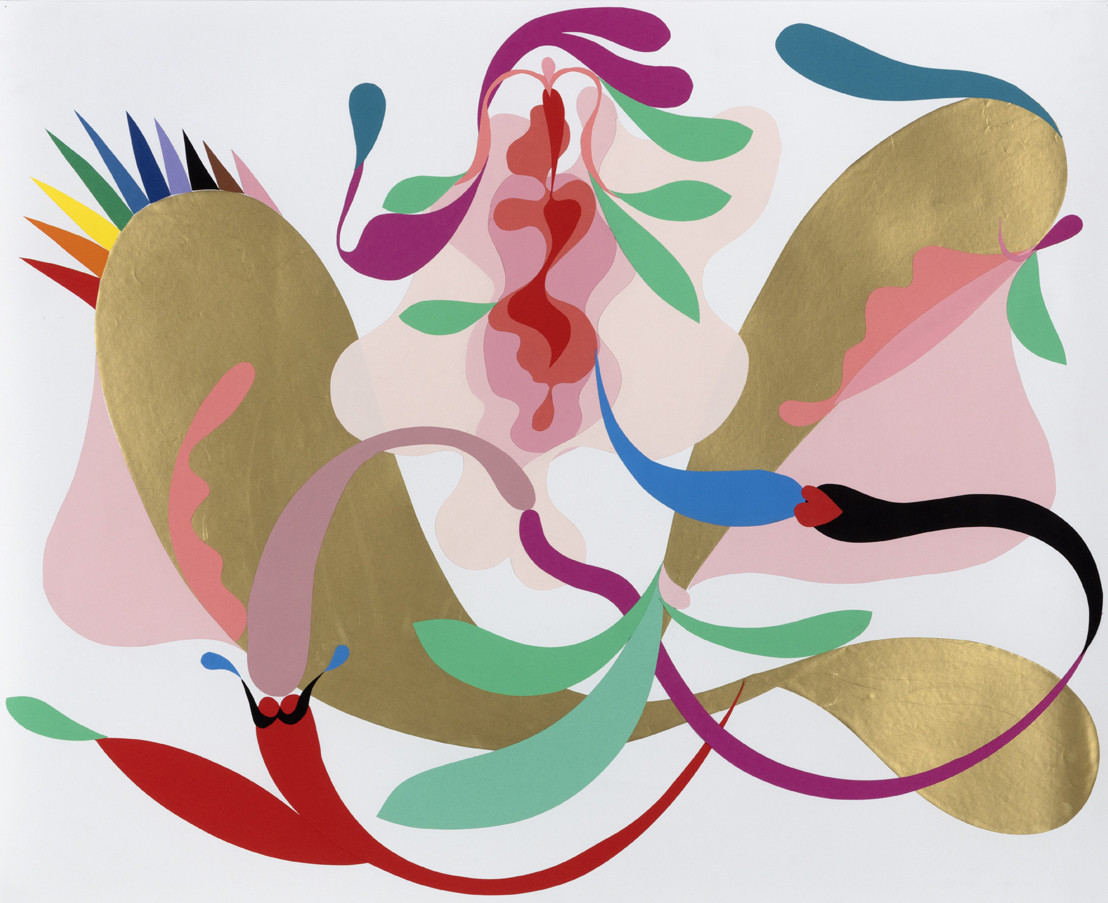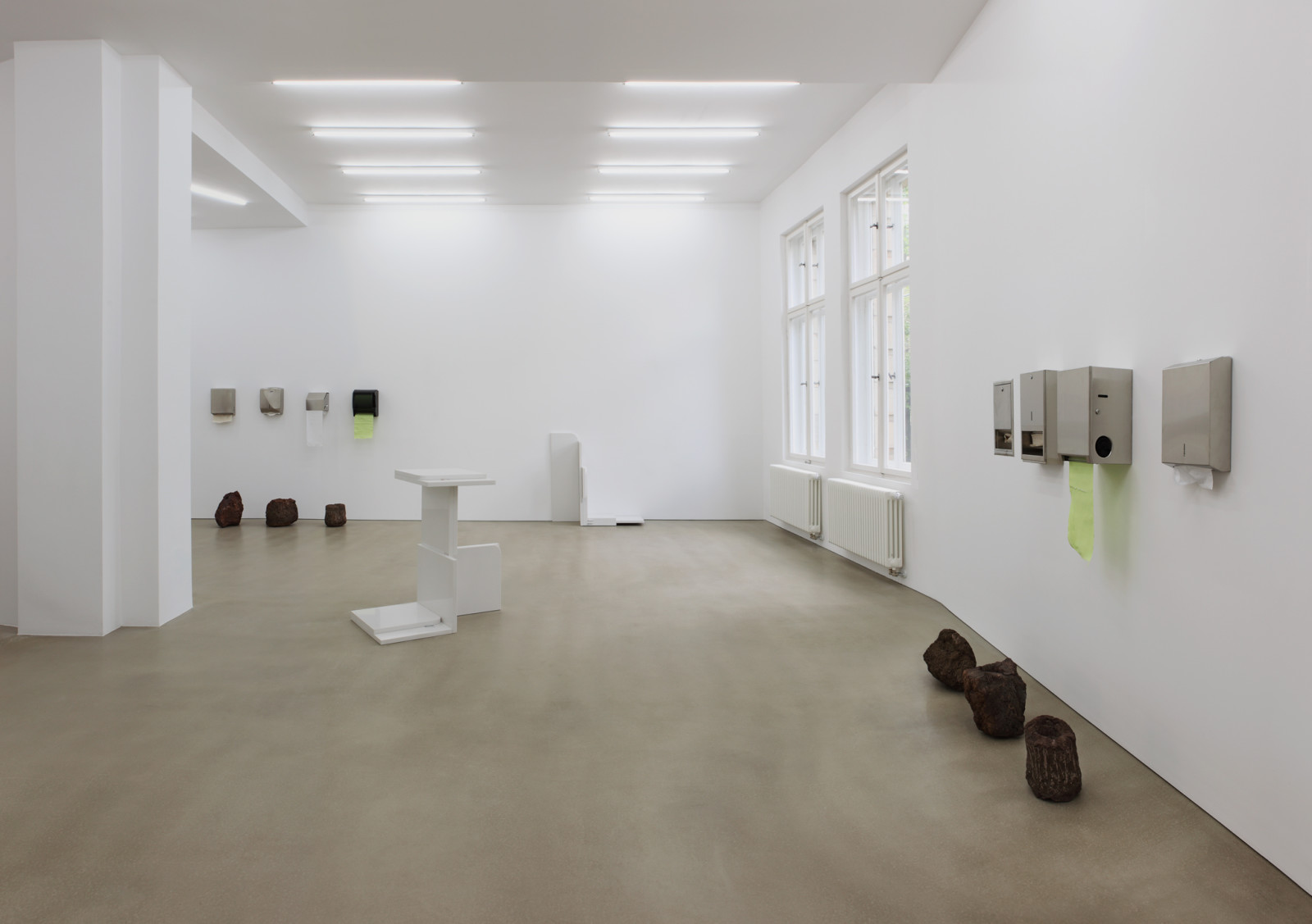Welcome to our Letter from Berlin!
This week we take Nathan Carter's wildly popular Behind the Scenes video as occasion for a portrait of the artist.
Emiliano Pistacchi, Director and Head of Production, writes about working with Gabriel Kuri whose tour of his studio you can watch below.
If you missed Isa Melsheimer’s Online Viewing Room or our new Guess Whose Studio, you can find links below.
Our photographer and friend Andrea Rossetti has picked one of his favorite exhibitions.
Please check our social media channels for our new formats, as artists open their (temporary) studios or share their responses to the situation. We want to continue to connect you with our artists, their works and ideas.
Read this in good health.
|
|
|
A Profile on Nathan Carter
|
|
Hopefully it will look loud!
A few years ago, I gave Nathan Carter a short text I had written on his work. He was visiting Berlin for the opening of the gallery’s new space and I was updating his profile. In response he gave me a list that I took as a kind of manifesto. Similar perhaps to the famous Pop Art list by the Independent Group, it is a mission statement, and as he recently noted,
“It was a defiant list of all the things that I as an artist will play with when I make art. The use of the word “play” means to experiment, touch, examine, alter and use in a fluid active way. The list is a license to be an artist and to make work about all of those things. Consequences n’all.” From abstraction to violence via bad weather, dancing, espionage, excitement, fear, love, pain, punk rock, shame, tequila & guacamole bar, among others—it’s all there.
I came across that list three weeks ago when I was preparing to work from home, and, on a whim, took it with me. It seemed like a good antidote to impending isolation.
The short video Carter sent last week, a behind-the-scenes view of his studio where he is currently working on a new film entitled LA GNARLIES, has a similar exuberance, a defiance of darkness.
Nathan Carter is known for playing with semi-fictional worlds—locations with brightly colored covert listening stations, data collection conduits or traveling circuses. His work engages with the history of abstraction, both in painting and sculpture, often taking the form of abstracted maps and landscapes, but fusing an abstract visual language with references to topical contemporary issues. His drawings of fictional surveillance and data collection scenarios for example, transformed their natural settings into somewhat garish dystopian industrial developments.
Carter’s inspirations have always been eclectic and wide-ranging. His art develops from this voracious intake of information, images, music, popular culture & mass media but also from a culture of exchange of ideas, an excess of words, accumulation of shapes, colors, crossing boundaries of media, overdetermined and wide-ranging associations, mining the exuberance of the visual world and of all social interaction.
In the last years, the dialogue with a group of women has highlighted this aspect of his creative process. His approach combines the classical notions of inspirational figures, 19th century ideals of community, 20th century anarchist ideas that found their expression in the work of the Situationists and the punk movement, as well as 21st century preoccupation with sharing images and information across platforms. His work can take the shape of anything from music, film, video, sculpture, photography, party dresses, a fingernail polish bar, jewelry, poetry, masks, costumes, performance, punk rock to dinners, dancers and danger.
Recent series of works—among them sculptures, drawings and collages—originated as actual or imaginary gifts, drawing on the artist’s fictional dialogue with several real-life women. The sources of inspiration are both real and elusive, literal and metaphorical, continuing the artist’s engagement with the worlds of abstraction and fiction. |
|
|
 | Nathan Carter, The DRAMASTICS: A Punk Rock Victory Twister in Texas, Nasher Sculpture Center, Dallas, 2017. Photo © Nasher Sculpture Center | |
|
The generous stance of Nathan Carter’s works and his exhibitions as fun-fueled events, encapsulates the exuberance associated with youth culture, yet at the center of his production is the excessive force of culture in general, the expenditure of creative energy as gift—generosity as anarchist gesture.
The point of departure for his earlier film, The DRAMASTICS Are Loud, was a series of figures he wanted to activate. Carter conceived the story, designed the characters, their clothes, all the props and sets, as well as creating entire streetscapes. The film follows four young women who found a fictional punk band, emerge from obscurity, perform a few shows, and become victims of their own brief success. The hand-held cut-out figures, animated with visible wires, have a surprising dynamism. The soundtrack features dialogue, sound effects, and music, performed by Carter and a number of collaborators and friends.
The film combined the depiction of characters with elements of Carter’s abstract formal vocabulary. In a recent interview the artist noted an emerging synchronicity during his work on the film: “When I started drawing the female figures in long party dresses it was really different from what I had done before. Through the nonsensical way of putting drawings of rockers with guitars next to a drawing with pure abstraction, they start to communicate. Maybe the abstraction is a backdrop for them playing music. Or maybe a skirt with an abstract pattern on it is worn by one of the band members.”
In addition, the production of the film took on a festive quality, accentuating a communal aspect long present in his work: “The activity of world-building felt like inventing and playing with punk dolls in their punk dollhouse. The entire process, of improvising and building and recording and filming, was like making a DIY basement recording. All of it looked and sounded immediate, fast, loose, and loud. Meticulous craft took a backseat to enthusiasm.” |
|
|
 | Nathan Carter, The DRAMASTICS are Loud, 2016, HD Film (colour, sound), duration 27:25 min
Film still © Nathan Carter | |
|
Similar to The DRAMASTICS are Loud, the focus of his new film LA GNARLIES is again on the daringness of self-invention but also considers the value of friendship and comradery. The new work—we see the main figures with sketches of their personalized skate- and surfboards and other props that will be part of the sets—more manifestly picks up on themes of inclusivity and kindness. The story is only superficially bizarre: magically transported from their idyllic albeit idiosyncratic California life of skating and surfing, the four protagonists find themselves in the harsh north of Scotland. They are not entirely lost on these alien shores: Thurso is a surfing Mecca on the northern coast, thus surfer culture gives them an entry. But they long to return to their temperate home. A gentle act toward the Haggis Monster by one of them opens this magical portal. Like most myths and fairy tales it has a simple, existential trajectory—a journey on which a misunderstood monster is conquered, in this case by the bravery of kindness.
Also visible in his studio are the exuberant new collages which continue his recent theme of playfully mixing abstract and organic shapes to create fantastic botanical compositions, named for flowers and vaguely resembling their distinct shapes. Made from golden foil and colored paper, the collages focus on flowers in the process of blossoming. Thus, among the tightly intertwined forms reminiscent of leaves and vines, are also stamen and stigma, evoking the complex reproductive apparatus of plants. Emphasizing the fantastic element of these constructions, they can also include hearts or a row of rainbow spikes, or, as Carter calls them: “visible deadly warnings to all away supporters and dream killers."
Carter’s behind-the-scenes video shares with us, in the best sense of that word, the excessive ebullience of producing something from the simplest means. From this paper, paint, music, and an abundant imagination the LA GNARLIES will rise. Tequila, Tecate, guacamole & weed may help.
– Isabelle Moffat |
|
|
 | Nathan Carter, Danae Dandelion (Deadly), 2019, paper and foil collage, 76,2 x 94 cm (unframed), 83,8 x 101,6 x 3,8 cm (framed)
| |
|
A behind-the-scenes look into Nathan Carter’s new film, LA GNARLIES, which features surfing & skating, a magic quesadilla and an infamous Haggis Monster… WATCH THE VIDEO HERE
|
|
|
 | Gabriel Kuri, I collate, I convey, I comply (06), 2015, green Anröchter stone, chipboard plinth, assorted objects, 66 x 55 x 50 cm (sculpture), 60 x 60 x 61 cm (plinth)
| |
|
Looking at the bookshelf across my table I noticed Gabriel Kuri’s catalogue Sorted/Resorted published for his Wiels exhibition. Home office has advantages and disadvantages. As work is for the most part done remotely, on a computer far from the offices, my surroundings have become richer, alive. All the objects collected in more than a decades start to speak again. I like to listen to these objects – to reconnect with the reality in which I found them. It is something I’ve always liked since I was going to the beach in summer: I found the things people left in the sand very fascinating – especially because they were also completely out of context. It was an idiosyncratic place, a desert land. When I met Gabriel in 2015 for his most recent solo exhibition at the gallery, this sense of research was activated in the same way. Among the works he made, there was a series of sculptures that were hosting found objects. In the heat of the summer, I was looking for a coffee cup, the one you use to take the coffee with you, and you realize that a plain one, the one that contains just the right sense he was looking for did not exist in Kreuzberg, at least in the surrounding 10 blocks or so of his studio at the time. This research became a way to map the city and ordering a coffe-to-go was no longer about the taste of the coffee but about the shape of the cup. – Emiliano Pistacchi WATCH GABRIEL KURI TALK ABOUT HIS PRACTICE IN HIS STUDIO HERE
|
|
|
Gabriel Kuri
sorted resorted
Publisher: WIELS, Brussels and Koenig Books, London
Language: Dutch, English, French
Available here
|
|
|
Online Viewing Room – Isa Melsheimer at KINDL, Berlin
|
|

| Isa Melsheimer in her exhibition at KINDL – Centre for Contemporary Art, Berlin, 2020
Photo © Oliver Mark | |
|
An exclusive behind the scene tour while the exhibition is closed due to the temporary closure of KINDL – Centre for Contemporary Art, Berlin. SEE INSIDE THE EXHIBITION HERE
|
|
|
A paintbrush, a camera, a robot, disregarded doorstops or even a ouija board – how much can you tell from an artist by what’s in their studio? We’re putting your knowledge to the test in this new series where our artists open the doors and invite you to work out whose studio you’re peering into… SEE INSIDE THE STUDIO HERE
|
|
|
A Journey Through the Archives
|
|
In the second installment of our team's favorite exhibitions from the history of the gallery, Andrea Rossetti, photographer and dear friend, speaks about why the 2011 Gabriel Kuri exhibition carbon index compost copy is particularly special to him.
“This was the very first exhibition I documented at Esther Schipper, so I have very special feelings when I think about it and remember the installations and artworks very vividly. It was also the very first show at the Schöneberger Ufer location, and I like the idea that both myself and the gallery have a shared milestone together.”
– Andrea Rossetti |
|
|

| Exhibition views: Gabriel Kuri, carbon index compost copy, Esther Schipper, Berlin, 2011
Photo © Andrea Rossetti | |
|
|
|